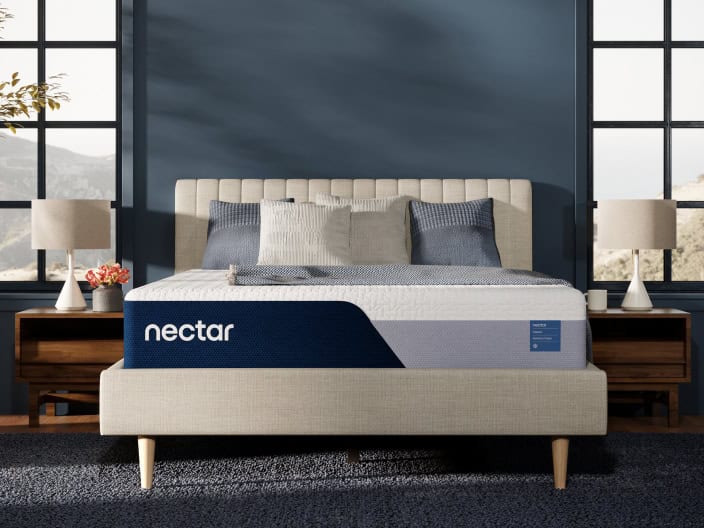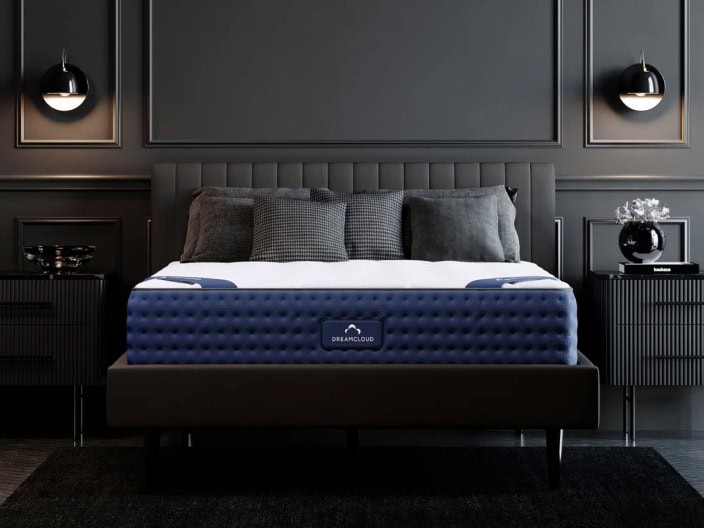Mattress Firmness Guide: Different Firmness for Different Sleepers
Share
Fact checked
Reviewed by experts
Updated
December 6, 2022
Quick read
10 mins to read
List of Content
The most daunting part of buying a new mattress is deciding the level of firmness. There are different mattress firmness levels each with its own features and benefits. Based on the materials used like foam or innerspring, the mattress comfort levels and firmness may change. There is no perfect mattress firmness for all sleepers. Your preference for firmness may vary according to your sleeping position, body weight, specific health condition and so on.
How to make the right mattress buying decision? Here is a mattress firmness guide to help you know the best firmness for a mattress and how to choose the right firmness for your bed.
What is Mattress Firmness?
The firmness of a mattress refers to how you feel the moment you lie on it. Does it feel soft or hard? Do you feel you are on the top of your mattress or feel you are sinking deep into it? Does it support your body contours? Does it cushion your pressure points like hips?
What determines the firmness of the mattress is the construction and materials used for the comfort system that is layered over a support core. The most common materials used are memory foam, polyfoam, latex, and fiber.
For manufacturing a firmer surface, a thin comfort layer is designed using less malleable materials. For manufacturing a softer surface, thick comfort layers are designed using more conforming materials. While comfort layers determine the firmness of the mattress, the mattress core determines the mattress support.
A thin layer separates the comfort system and the support core. This is designed to balance the contouring and support. A support core is so designed that it prevents the sleeper from sinking deep into the mattress. The aim is to make the mattress supportive for neutral spinal alignment.
(Please note firmness and support are not the same. The difference between both is discussed later in the post.)
Preference for mattress firmness varies from a person to person depending on factors like body type, weight, sleeping position, and others. So, the same mattress may be comfortable and supportive for you but not for your partner.
Mattress Firmness Levels
Below are the four broad categories of mattresses. Mattresses with different levels of firmness are discussed in detail in the subsequent sections.
1. Soft
A soft mattress scores 1-2 on the scale of mattress firmness. This type of mattress has memory foam material, used for the mattress support core. It adds soft comfort layers making sleepers feel comfortable. However, there might be an off-gassing odor when taken straight out of the delivered package.
- You will sink into this mattress while sleeping because it provides the least support.
- It conforms to your body and offers great body contouring
- Best mattress firmness for side sleepers
- People with hip or shoulder pain can find relief sleeping on a soft mattress
- Some people may sleep hot on soft comfort layers
- Unlike firmer ones, soft mattresses don’t last long
2. Medium-Soft
Medium-soft mattresses score 3 or 4 on the mattress firmness scale. Made of firmer memory foam or synthetic latex, but contains foal material for softer comfort layers. It provides more core support as compared to the soft mattress. The softer comfort layer ensures pressure point relief and gives the user a combination sleeping experience. However, there might be an off-gassing odor when taken straight out of the delivered package.
- You will not sink into it as deeply as you do with mattresses of soft firmness
- Supports body contouring
- An ideal choice for people who are looking for something in between soft and firm.
- Not comfortable for people with spine problems
- It may last longer than soft mattresses but have a shorter life span than firmer mattresses
- Traps heat, may cause discomfort for people who get hot when asleep
3. Medium-Firm
Medium-firm mattresses score between 5-7 on the mattress firmness scale. This is the level of mattress firmness for most ‘universal comfort’ mattresses. Unlike soft and medium-soft mattresses, medium-firm mattresses are made of dense and durable materials – a combination of soft foam and high-density poly foam or pocketed coils.
- Medium-firmness gives nice-level body contour along with adequate pushback
- Offers a noticeable amount of bounce
- Comfortable for different body types and supports different sleep positions
- Affordable price as compared to the softer mattress firmness levels, but the cost may be higher than firmer mattresses
- They last longer than softer mattress firmness levels
4. Firm
Firm mattress scores 7-10 on the mattress firmness scale. It is made of solid, sturdy materials (polyfoam or springs combined with soft foam) for comfort layers and the support core. Hence, it provides the most support when compared to mattresses that score below 7 on the firmness scale.
- You will not sink at all when sleeping on firm mattresses
- Provides a high level of spinal support for heavier sleepers
- Supportive and comfortable for stomach sleepers
- Slightly uncomfortable for side sleepers, may result in numbness and tingling sensation, and even pain.
- Doesn’t trap heat, allows maximum airflow, and keeps users cool at night
- Less expensive and more durable than softer mattress firmness levels.
Mattress Firmness Scale
Depending on the manufacturer, the system of measuring mattress firmness may vary. A ten-point scale is widely used, where 1 indicates the mattress to be softest and 10 indicates firmest. Medium firmness is marked by a score of 6.5/10 and is considered the industry standard. This system of firmness measurement easily helps you compare different mattress models based on firmness and feel.
Check out the mattress firmness chart:
| Firmness Level (1-10) | Feel | Description |
|---|---|---|
| 1 | Extra soft | Sink significantly, Conform closely to the body |
| 2-3 | Soft | Sink, Conform considerably |
| 4 | Medium soft | Sink some, Conform relatively closely. |
| 5 | Medium | Sink less, Conform noticeably |
| 6 | Medium Firm | Do not sink much, conform moderately. |
| 7-9 | Firm | Do not sink at all , Minimal Conforming |
| 9-10 | Extra Firm | No sinkage at all , Do not conform at all |
Now let’s discuss in detail what different firmness levels say about a mattress and its performance.
Extra Soft to Soft (1-3 out of 10)
Mattresses that score between 1 and 3 on a ten-point scale are classified as soft or plush.
- Very supportive and comfortable for people having weight – 130 pounds.
- Ideal for side sleepers
- Those who sleep on back or on their stomach may sink in too deeply or have poor spinal alignment
- Soft and conform closely to your body which gives a hugging sensation
- Relieves pressure, so comfortable for people with sharp pressure points,
- Trap heat so you may sleep hot
- Soft mattresses have a shorter life-span than firmer mattress
- Thick comfort layers made of memory foam or latex, make it pricey
- Less demand for the extra soft mattresses, hard to find in the market
- Soft mattresses are more easily available
Medium Soft to Medium Firm (4-6 out of 10)
Mattresses that score between 4 and 6 on a ten-point scale are quite popular. Most manufacturers design mattresses of this firmness range.
- Medium soft to medium-firm mattresses are moderately supportive and comfortable for people with weights between 130 and 230 pounds
- They are ideal for couples with different body types and sleeping positions to sleep together
- Sink less than soft or extra soft mattresses
- Offers a good balance of contouring and support.
- Provides pressure relief
- Traps less heat than softer models
- Longer lifespan than softer models due to use of sturdier materials
- Low cost due to less substantial comfort system. Some places the price can be competitive depending on the demand
Firm to Extra Firm (7-10 out of 10)
Mattresses that score between 7 and 10 are fairly popular and are sold by most retailers.
- Firm to extra firm mattresses offer exceptional support to people having weight over 230 pounds
- Ideal for stomach sleepers to limit sinking and maintain healthy spinal alignment
- Do not contour closely to your body due to thinner comfort layers that do not contour closely.
- Side sleepers weighing over 230 pounds may feel pressure buildup around shoulders and hips.
- Less likely to trap heat allowing air to flow
- The use of sturdier material makes it highly durable than mattresses that rate less than 7 out of 10
- No unnecessary padding used, so the price is lower than softer models with thick comfort layers
What Is the Best Firmness for a Mattress?
1. Sleeping Positions
Back Sleepers
For weight under 130 lbs – the best firmness for you is a soft to medium mattress
For weight between 130 and 230 lbs – medium to medium-firm
For weight over 230 lbs – a firm mattress is best for you
Back sleepers need adequate support for the lumbar region. A firm mattress is best for them because it prevents sagging in the midsection.
Side Sleepers
For weight under 130 lbs – go for soft to medium soft mattress
For weight between 130 and 230 lbs.- choose medium soft to medium mattress firmness
For weight over 230 lbs.- choose medium-firm to firm mattress
Side sleepers put extra pressure on their hips and shoulders so the best mattress firmness for side sleepers is the one that cradles the body as well as prevents pressure build-up and spinal misalignment.
Stomach Sleepers
For weight under 130 lbs – go for soft to medium soft mattress
For weight between 130 and 230 lbs – Choose Medium to medium-firm
For weight over 230 lbs – A firm mattress is the best choice
Side sleepers need a firm mattress to prevent sagging in the midsection and damage to the natural spinal curve that may increase the risk of pain and injury.
2. Sex
Mattresses that score 4-6 or 7-10 on a ten-point mattress firmness scale are best for sex. Medium soft to medium-firm mattresses are best recommended because they provide enough comfort and support for sexual activity, besides providing contouring and traction.
A firm mattress is also a good choice because they prevent mattress sinkage and allow sufficient body movement.
3. Weight
People with different weights exert a different level of pressure on the mattress which affects the preference for firmness and comfort.
Heavy
For weight, more than 230 lbs.- medium-firm, firm, and extra firm are best-recommended firmness levels. They offer spinal support and don’t conform as closely.
Light
For weight, less than 130 lbs – soft, medium soft, and medium are best-recommended firmness levels. They are soft and close conforming and promote good posture.
3. Pain
Back Pain
Back pain occurs when your mattress is sagging in the midsection or there is a lack of proper support. Choose a firm mattress that gives ample support in the comfort and support layer and a good cushion to support the natural curve of your spine.
Hip Pain
Hip pain occurs when the mattress is very hard and doesn’t support the natural curves of your hips. For side sleepers with hip pain, a softer mattress is best. It will help relieve pressure and tight muscles to relax. If you prefer a firm mattress then simply add a soft mattress topper to combat hip pain.
Shoulder Pain
A plush or softer mattress is an ideal choice for a side sleeper with shoulder pain because they provide adequate pressure relief.
How to Choose Mattress Firmness?
1. Body Weight
Soft or medium-soft mattresses are ideal for lightweight people, while firm mattresses are best for heavier people because they need more support. Those with average weight can choose any mattress firmness level.
2. Preferred Sleeping Position
Do you sleep on the side or stomach or on your back? Considering your sleeping positions will narrow down your options while choosing the mattress firmness. Side-sleepers require a soft mattress with enough cushion and support to prevent pain on their pressure points on hips and shoulders.
On the other hand, back sleepers require medium-firm mattresses for ample spinal support to prevent back pain. Those who love to sleep on their stomach require a firm mattress for strong support to maintain the natural curve of the spine. People who switch their sleeping positions from time to time require medium-firm mattresses.
3. Number of Sleepers
If you sleep alone you can choose a mattress firmness that supports your body type and sleeping positions. If you sleep as a couple, check out if the mattress supports your and your partner’s needs. In case there is a mismatch, choose a mattress with a medium firmness level.
4. Spine Health
To alleviate or prevent back pain, avoid soft mattresses, as you will sink deep into them when asleep. Soft mattresses don’t provide enough support. Whereas, medium-firm to firm mattresses are best for spinal alignment and offer most support when compared to softer mattresses.
5. Tendency to Sleep Hot
Mattresses made of memory foam for a softer comfort layer trap heat. So, the sleeper may feel hot when asleep. However, if your body needs a soft mattress, but you have the tendency to sleep hot, buy soft mattresses having optimum temperature control. Or you may buy a firm mattress with a minimal sinkage that allows more airflow and helps you sleep cooler.
6. Price
Soft beds have thicker comfort layers hence cost high because they require more material. Firmer beds have thinner comfort layers so they cost less. But, the price may vary for both soft and firm mattresses based on unique design and additional features.
Is Firmness the Same as Support?
Firmness is not equal to support! Although both terms are used synonymously, there is a difference between firmness and support. The firmness of a mattress refers to the ‘feeling’ that you get when you sleep on your mattresses. Whereas support refers to how well the mattress encourages spinal alignment.
It is not necessary that only firm mattresses offer great support. Even soft mattresses can offer support and meet your pressure-relief needs. There are some firm mattresses, which do not keep your spine in neutral alignment. So, before buying a new bed check out how the mattress makes you feel, whether it gives you enough cushion, relieves pressure, and offers pushback or not.
If you feel confused and clueless about how to choose the right firmness level, simply go for a medium-firm mattress that is famous for satisfying most sleepers.
Adjustable, Flippable, and Dual-Firmness Mattresses
There are people with fluctuation in mattress firmness preferences. Buying a mattress with a fixed firmness level can sometimes lead to compromised sleep. The good news is some manufacturers are selling mattresses with multiple built-in firmness options. Below are three different types of mattresses with this outstanding facility:
Adjustable Mattresses:
- Designed like airbeds with chambers that can be filled or emptied as per your requirement
- Adjustable firmness mattresses have a set range of firmness levels
- You can change the firmness level as you wish using an app, remote, or just manually
- Expensive, but highly supportive for people whose preference for mattress firmness keeps changing
Flippable Mattresses:
- Designed to have two comfort layers and a shared support core
- Both sides have two different firmness level
- The sleeper can use either side for sleeping and flip the mattress as per your sleep requirements
Dual-Firmness Mattresses:
- The sleep surface is split into two, each with a different firmness level
- The ideal mattress for couples
- Each partner can choose the surface that most suits their body type and sleep needs
- Mostly available in queen and larger size
What Affects the Firmness of a Mattress?
There are different types of mattresses made of different materials for comfort layers and support core. The material used has a great impact on the firmness of the sleep surface. Depending on the material, the feel and the performance of the mattress can change. Below are four types of mattresses defined by their materials:
Innerspring
Innerspring mattresses use a coil support core that is made of steel. The comfort layers are not very thick in most cases so they offer firmer feels.
These mattresses are designed to be supportive and bouncy. They are known to be breathable. The performance of innerspring mattresses is influenced by coil pattern and gauge.
Foam
Foam mattresses are made of memory foam, polyfoam, and/or latex material which makes them softer as compared to other mattress types.
They are designed to conform closely to your body and prevent pressure-point pain. Some manufacturers sell foam mattresses with firm options
Hybrid
Hybrid mattresses are the combination of an innerspring mattress’s coil support core and a thicker comfort layer made of latex or foam. Therefore, they are durable!
These mattresses are available in a range of firmness options and the sleeper can choose the mattress that best suits their firmness level. They are designed to be responsive and provide body contouring to relieve pressure.
Latex
Latex mattresses are very responsive and have a long lifespan. Different latex models may have different firmness levels.
This type of mattress is designed to spread the sleeper’s body force over a wide area. Thereby, it limits shrinkage and provides sufficient pressure relief.
Please note: Each of the above four mattress types may vary in terms of design and materials even if they have similar constructions.
Bottom Line
Mattress firmness has a huge impact on comfort and support for different types of sleepers. The right firmness for you is the one that offers enough cushion and prevents spinal misalignment. Other factors to consider when selecting the mattress firmness is your body weight, sleeping position, tendency to sleep hot, price, and durability.
Are you ready to place an order? Contact us now!
FAQ:
Here are some tips:
- Flip the mattress if you have a flippable bed or rotate the mattress so that fillings are evenly distributed
- Add a mattress topper for better resistance and support
- Replace the worn-out layers
- Add plywood directly under the mattress to prevent sagging
- Check and replace platform or box spring
- Look for new bed frames or slats
Hotels mostly use medium-firm range mattresses.
It provides a balance between softness and firmness.
This website does not offer medical advice nor professional medical services; rather, it is provided solely for educational, informational, and/or entertainment purposes. Individuals seeking medical advice should consult a licensed physician. The information provided should not be used for diagnosis or treatment of any condition, disease, or injury. When you have a medical condition, you should always talk to licensed doctor or other certified medical professional. You should never delay seeking professional medical advice or treatment based on the contents of this website. Call 911 or immediately go to the nearest emergency room if you think you may have a medical emergency. The contents of this website are provided “as-is”, Sleep Authority and its parent, subsidiaries, affiliates, employees, contributors disclaim any warranty of the information contained herein. Please contact using contact form to report any errors, omissions, misinformation, or abuse.
Sleep Authority is brought to you by Resident, the company that brings you Nectar, DreamCloud, Awara, Wovenly, Bundle, Home Well Designed and Level Sleep.




